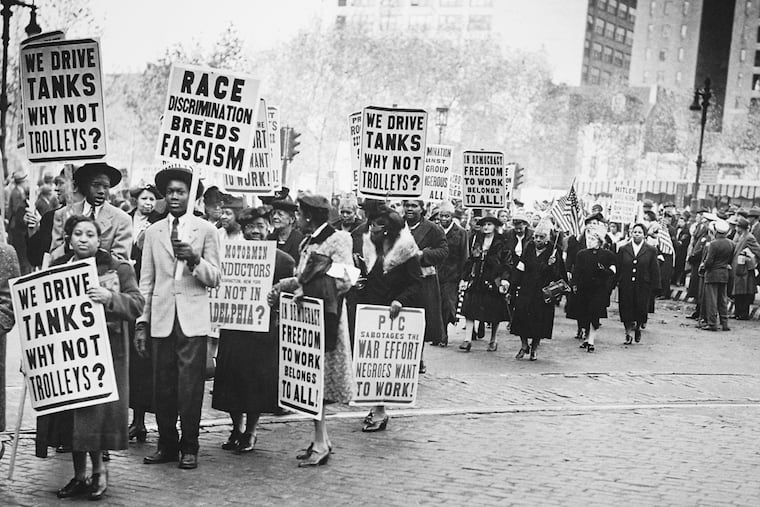A Million Faces: This John W. Mosley exhibit will leave Philadelphians reminiscing

In 1962, photographer John W. Mosley snapped a photo of President John F. Kennedy flanked by then-Philadelphia Mayor James H.J. Tate and two U.S. senators.
Kennedy and the high-ranking politicians, however, were not the stars of this particular composition. Instead, Mosley's image focused on the young, wide-eyed Alphonso Boyer, a police officer stationed at Independence Hall during the annual July Fourth celebration, and the only African American in the photo.
Mosley, who died in 1969, was one of America's first black syndicated photographers. But unlike his contemporary Gordon Parks, who focused on poverty, Mosley also celebrated hard-won triumphs and everyday stories of black people in segregated Philadelphia during the 1940s, '50s, and '60s — a time when many believe America was at its greatest.
His genuine images of black leaders such as W.E.B. Dubois and celebrities including Lena Horne and Pearl Bailey appeared regularly in black newspapers up and down the East Coast. In Pennsylvania, many of his photographs were featured in the Philadelphia Tribune, the Pittsburgh Courier, and a few made the pages of the Philadelphia Evening Bulletin.
Right now, about a hundred of Mosley's photos are on display in the Woodmere Art Museum show "A Million Faces: The Photography of John W. Mosley." The exhibit in Chestnut Hill, which runs through Jan. 16, fills three of the museum's cavernous galleries and is the first major showing of Mosley's work in life and death.
"We wanted to illustrate the vitality of the community that lived in Philadelphia at the time," said Rachel McCay, assistant curator at Woodmere. "There is so much life there, and Mosley captures it through his lens."
For many African Americans who look at these pictures on the museum's stark white walls, it will be like a trip through your mother's, grandmother's, or great-grandmother's photo albums, with your smiling aunties and uncles dressed to the nines in their Sunday best. Hats are on. Coats are long. Suits are dapper.
Waists are nipped. Most of these black people, whether at cotillions or 110th birthday parties, are having a good time.
Many Philadelphians might be lucky enough to catch a glimpse of a friend or family member frolicking on Belmont Plateau in Fairmount Park or at Parkside Athletic Field, leaving the Academy of Music from its "colored only" entrance, or networking at Girard Avenue's Pyramid Club. Woodmere, in fact, encourages visitors to add memories of people and places on its website: woodmereartmuseum.org.
But a fair amount of Mosley's photos were candid shots of the heaviest hitters in the black entertainment world. There is a 1946 photo of blues singer Billie Holiday with comedian Spizzy Canfield.
Also in the collection are quite a few images of opera singer Marian Anderson: one with first lady Eleanor Roosevelt in 1943, another with the members of the Alpha Kappa Alpha sorority in 1944, and one in 1963 with Princess Grace Kelly at the Philadelphia Museum of Art.
Mosley got Brooklyn Dodger Jackie Robinson when his team was in town to play the Phillies in 1951. And there is even a young Bill Cosby throwing a javelin on Temple's campus in 1961 — as though he somehow knew Cosby would become a star.
"My dad was always out and about," said John W. Mosley Jr. He remembers his dad developing pictures in the Christian Street YMCA, not far from where the family of four lived in South Philadelphia. Later, Mosley said, when he was 14, the family moved to West Philadelphia, where the now-70-year-old son still lives.
The Mosleys didn't have a car, Mosley said, so his dad walked everywhere. He worked every day, too, sometimes shooting up to five or six events a day. Among the older Mosley's favorite things to cover were worship services, to which his son often tagged along.
"Every day he was out and about, he came home, he took pictures, and he spent a lot of time developing them. It was just his routine, and it was our life."
The Woodmere Museum worked with Temple University's Charles L. Blockson Collection to build the exhibit. Blockson, a noted historian of African American history, became friends with Mosley's widow, Teresa — a descendant of the William Still family, prominent abolitionists — in the 1980s.
In 1984, Mosley's wife gave more than 300,000 of Mosley's negatives and photographs to Blockson to include in the collection, its curator, Diane D. Turner, said.
Last year, Woodmere curated "We Speak: Black Artists in Philadelphia, 1920s-1970s" and included four of Mosley's works. In addition to being a stellar lifestyle photographer, Mosley played with composition and lighting — that's especially evident in his photos of Chicken Bone Beach, Atlantic City's sandy segregated playground.
"He was self-taught," museum director William Valerio said. "He combined the exploration of learning how to use the tools: The Graflex camera that he used was a new type of camera that took studio photography out in the streets. He was part of a generation of photographers learning how to use that tool. It was complicated."
This year, the museum's staff, as well as the keepers at the Blockson Collection, began combing through the hundreds of thousands of pictures. About half a dozen photos taken in the 1950s are from Chicken Bone Beach, including one of the Rev. Dr. Martin Luther King Jr. in a groovy two-piece bathing suit, one of Sammy Davis Jr. and his entourage, and another of boxer Joe Louis. The rest of the show is divided into 12 topics, including politics and elections, jazz, religion, and social life. It took about year and cost $50,000 to organize the entire exhibition.
"A Million Faces" includes only two pictures of Mosley: one when he was in his late 20s, having recently moved to Philadelphia in 1934 from his hometown of Lumberton, N.C., and another in the '60s, probably a few years before his death.